Quick Summary:
- Build a fast, secure, mobile-friendly website.
- Showcase expertise with quality content and case studies.
- Optimize landing pages and CTAs for lead conversions.
- Attract clients through backlinks and social media.
Table of Contents
- I. Foundation: Building a High-Performing SEO Consultant Website
- A. Core Principles: User Experience and SEO Harmony
- B. Essential Technical SEO Elements
- II. Showcasing Expertise: Content Strategy and Service Offerings
- A. Content Pillars: Demonstrating Authority and Value
- B. Showcase Your Services: Clear and Compelling Service Offerings
- III. Lead Generation and Conversion Optimization
- A. Optimizing Landing Pages for Conversions
- B. Effective Call-to-Actions (CTAs)
- C. Contact Forms and Lead Capture
- IV. Website Promotion and Authority Building
- A. Building High-Quality Backlinks
- B. Leveraging Social Media
- C. Local SEO Optimization (If Applicable)
- V. Analytics and Reporting
- A. Setting Up Google Analytics and Google Search Console
- B. SEO Reporting and Client Communication
- VI. Qrolic Technologies: Your Partner in Digital Growth
- VII. Conclusion: Building a Winning Website for SEO Success
I. Foundation: Building a High-Performing SEO Consultant Website
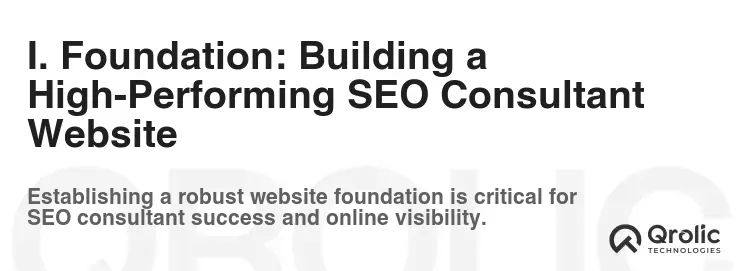
A. Core Principles: User Experience and SEO Harmony
1. Prioritizing User Experience (UX):
-
What is UX and Why Does it Matter? User experience encompasses everything a visitor feels and interacts with when on your website. A positive UX results in longer session durations, lower bounce rates, and ultimately, more leads. Google prioritizes websites with excellent UX.
-
Key UX Elements: Focus on site speed, mobile responsiveness, clear navigation, and an engaging design. Ensure your website is easy to use and understand, regardless of the device or browser.
-
Measuring UX: Tools like Google Analytics and Hotjar provide valuable insights into user behavior. Track metrics like time on page, bounce rate, and conversion rates to identify areas for improvement.
2. SEO-Friendly Website Architecture:
-
Crawlability and Indexability: Search engines need to be able to easily crawl and index your website. This starts with a well-structured site architecture and a clear sitemap.
-
URL Structure: Use descriptive, keyword-rich URLs that are easy to understand for both users and search engines. For example,
qrolic.com/seo-services/keyword-researchis better thanqrolic.com/page123. -
Internal Linking: Strategically link relevant pages within your website. This helps search engines understand the relationships between your content and improves the flow of authority.
B. Essential Technical SEO Elements
1. Mobile-First Indexing Optimization:
-
Understanding Mobile-First Indexing: Google primarily uses the mobile version of a website for indexing and ranking. This means your website must be fully responsive and provide an excellent mobile experience.
-
Mobile Responsiveness Testing: Use Google’s Mobile-Friendly Test to ensure your website is optimized for mobile devices. Address any issues related to content rendering, tap targets, and viewport configuration.
-
AMP (Accelerated Mobile Pages): Consider implementing AMP for key landing pages to improve loading speed and enhance the mobile user experience. Although not essential for ranking, it can significantly improve UX.
2. Website Speed and Performance Optimization:
-
Page Load Speed Importance: Page load speed is a crucial ranking factor. slow-loading websites lead to higher bounce rates and lower engagement.
-
Speed Optimization Techniques:
- Image Optimization: Compress images without sacrificing quality using tools like TinyPNG or ImageOptim.
- Caching: Implement browser caching to store frequently accessed resources locally.
- Minification: Minify HTML, CSS, and JavaScript files to reduce file sizes.
- Content Delivery Network (CDN): Use a CDN to distribute your website’s content across multiple servers, reducing latency for users in different geographic locations.
- Lazy Loading: Implement lazy loading for images and videos to load content only when it’s visible in the viewport.
-
Speed Testing Tools: Use tools like Google PageSpeed Insights, GTmetrix, and WebPageTest to identify and address performance bottlenecks.
3. Schema Markup Implementation:
-
What is Schema Markup? Schema markup is structured data that helps search engines understand the content on your website. It provides context and enhances search results with rich snippets.
-
Relevant Schema Types for SEO Consultants:
- Organization: Define your business name, logo, contact information, and social profiles.
- Service: Specify the types of SEO services you offer.
- LocalBusiness: If you have a physical office, include your address, phone number, and business hours.
- Review: Display customer reviews and ratings directly in search results.
- Article/BlogPosting: Mark up your blog posts to help search engines understand their content and structure.
-
Schema Markup Testing: Use Google’s Rich Results Test to validate your schema markup and ensure it’s implemented correctly.
4. Site Security (HTTPS):
-
HTTPS Encryption: Ensure your website uses HTTPS encryption to protect user data and build trust. Google prioritizes secure websites.
-
SSL Certificate Installation: Obtain and install an SSL certificate from a reputable provider.
-
Mixed Content Errors: Resolve any mixed content errors that may occur when serving secure and insecure content on the same page.
II. Showcasing Expertise: Content Strategy and Service Offerings

A. Content Pillars: Demonstrating Authority and Value
1. Defining Your Niche and Target Audience:
-
Niche Specialization: Focus on a specific niche within the SEO industry to establish yourself as an expert. This could be e-commerce SEO, local SEO, technical SEO, or a specific industry like healthcare or finance.
-
Target Audience Personas: Create detailed personas of your ideal clients. Understand their pain points, goals, and search behavior. This will help you create content that resonates with them.
2. Building a Comprehensive Blog:
-
Keyword Research and Topic Selection: Conduct thorough keyword research to identify relevant topics that your target audience is searching for. Use tools like SEMrush, Ahrefs, and Google Keyword Planner.
-
Content Calendar and Planning: Create a content calendar to plan and schedule your blog posts. Focus on creating high-quality, informative, and engaging content.
-
Evergreen Content Creation: Develop evergreen content that remains relevant over time. This could include comprehensive guides, tutorials, and case studies.
3. Case Studies: Proving Your Successes (Ranking Case Studies)
-
The Power of Case Studies: Case studies are a powerful way to demonstrate your expertise and build trust with potential clients. They provide concrete evidence of your ability to achieve results.
-
Structure of a Compelling Case Study:
- Client Background: Provide context about the client’s business, industry, and challenges.
- Goals and Objectives: Clearly define the client’s goals and objectives.
- Strategy and Implementation: Describe the SEO strategies and tactics you implemented.
- Results and Outcomes: Quantify the results you achieved, including improvements in rankings, traffic, leads, and conversions.
- Conclusion and Key Takeaways: Summarize the key takeaways from the case study and highlight the value you provided to the client.
-
Visualizing Results: Use charts, graphs, and screenshots to visually represent the results of your case studies.
4. Free Resources and Lead Magnets:
-
Offering Value Upfront: Provide free resources and lead magnets to attract potential clients and build your email list.
-
Types of Lead Magnets:
- Ebooks and Guides: Create comprehensive ebooks and guides on relevant SEO topics.
- Checklists and Templates: Develop checklists and templates that clients can use to improve their SEO efforts.
- Webinars and Workshops: Host webinars and workshops to share your expertise and engage with potential clients.
- SEO Audit Tools: Offer a free SEO audit tool that provides a basic analysis of a website’s SEO performance.
B. Showcase Your Services: Clear and Compelling Service Offerings
1. Defining Your SEO Service Packages (Service Offerings):
-
Tailoring Packages to Different Needs: Offer a range of SEO service packages to cater to different client needs and budgets.
-
Types of SEO Services:
- Keyword Research: Identifying relevant keywords for your target audience.
- On-Page Optimization: Optimizing website content and structure for search engines.
- Off-Page Optimization: Building backlinks and promoting your website to increase its authority.
- Technical SEO: Addressing technical issues that may be hindering your website’s performance.
- Local SEO: Optimizing your website for local search results.
- E-commerce SEO: Optimizing your online store for search engines.
- SEO Audits: Conducting comprehensive audits to identify areas for improvement.
- Content Marketing: Creating and promoting valuable content to attract and engage your target audience.
- Penalty Recovery: Helping websites recover from Google penalties.
- SEO Consulting: Providing expert advice and guidance on SEO strategies.
-
Transparent Pricing: Clearly communicate your pricing structure. Consider offering tiered packages with different features and levels of service.
2. Detailed Service Descriptions:
-
Clearly Explaining What You Offer: Provide detailed descriptions of each service you offer, highlighting the benefits and value clients will receive.
-
Focusing on Client Benefits: Focus on how your services will help clients achieve their goals, such as increasing traffic, leads, and sales.
-
Using Actionable Language: Use clear and concise language that is easy to understand. Avoid jargon and technical terms.
3. Client Testimonials and Social Proof:
-
Building Trust and Credibility: Include client testimonials and social proof on your website to build trust and credibility.
-
Requesting Testimonials: Ask satisfied clients to provide testimonials about their experience working with you.
-
Displaying Reviews and Ratings: Display reviews and ratings from platforms like Google My Business, Yelp, and Clutch.
III. Lead Generation and Conversion Optimization
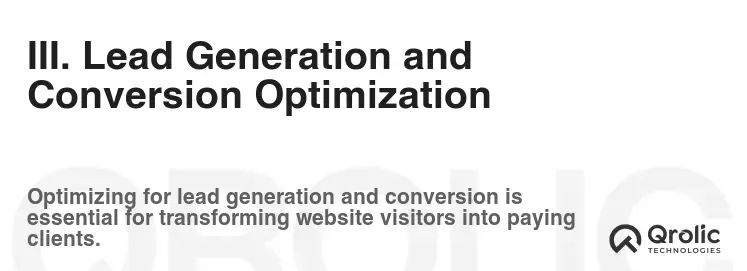
A. Optimizing Landing Pages for Conversions
1. Understanding Landing Page Optimization (LPO):
-
The Importance of Landing Pages: Landing pages are designed to convert visitors into leads or customers. They should be focused, targeted, and optimized for specific goals.
-
Key Elements of a High-Converting Landing Page:
- Compelling Headline: Grab the visitor’s attention and clearly communicate the value proposition.
- Clear Value Proposition: Explain the benefits of your services in a concise and compelling way.
- Strong Call to Action (CTA): Tell visitors exactly what you want them to do, such as requesting a consultation or downloading a resource.
- Visually Appealing Design: Use a clean and professional design that is easy to navigate.
- Social Proof: Include testimonials, reviews, and case studies to build trust and credibility.
- Mobile Optimization: Ensure your landing page is fully responsive and optimized for mobile devices.
- Fast Loading Speed: Optimize your landing page for speed to improve user experience and conversion rates.
2. A/B Testing and Continuous Improvement:
-
Testing Different Elements: Use A/B testing to experiment with different headlines, CTAs, images, and layouts to identify what works best for your target audience.
-
Tools for A/B Testing: Use tools like Google Optimize, Optimizely, and VWO to conduct A/B tests.
-
Analyzing Results and Making Adjustments: Continuously analyze your A/B testing results and make adjustments to your landing pages based on the data.
B. Effective Call-to-Actions (CTAs)
1. Placement and Design of CTAs:
-
Strategic Placement: Place CTAs in prominent locations on your website, such as above the fold, within content, and at the end of pages.
-
Visually Appealing Design: Use visually appealing buttons and colors that stand out from the surrounding content.
-
Clear and Concise Language: Use clear and concise language that tells visitors exactly what you want them to do. Examples include “Request a Free Consultation,” “Download Our Free Guide,” and “Get Started Today.”
2. Optimizing CTAs for Different Stages of the Buyer’s Journey:
-
Awareness Stage: Use CTAs that offer valuable information and resources, such as “Download Our Free Ebook” or “Read Our Latest Blog Post.”
-
Consideration Stage: Use CTAs that offer more personalized assistance, such as “Request a Free Consultation” or “Get a Free SEO Audit.”
-
Decision Stage: Use CTAs that encourage visitors to take action, such as “Get Started Today” or “Contact Us for a Quote.”
C. Contact Forms and Lead Capture
1. Optimizing Contact Forms for Lead Quality:
-
Minimizing Form Fields: Keep your contact forms short and simple to maximize conversion rates. Only ask for essential information.
-
Using Smart Fields: Use smart fields to dynamically adjust the form based on the visitor’s behavior and information they have already provided.
-
Providing a Clear Privacy Policy: Assure visitors that their information will be kept confidential and used responsibly.
2. Integrating with CRM Systems:
-
Streamlining Lead Management: Integrate your contact forms with a CRM system to streamline lead management and improve follow-up.
-
Popular CRM Systems: Consider using popular CRM systems like HubSpot, Salesforce, or Zoho CRM.
IV. Website Promotion and Authority Building
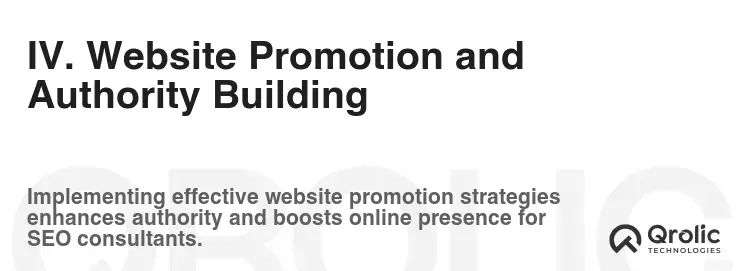
A. Building High-Quality Backlinks
1. Understanding Backlink Importance:
-
Backlinks as a Ranking Signal: Backlinks are a crucial ranking factor. They are a signal to search engines that your website is trustworthy and authoritative.
-
Quality vs. Quantity: Focus on building high-quality backlinks from reputable websites rather than acquiring a large number of low-quality backlinks.
2. Backlink Acquisition Strategies:
-
Guest Blogging: Write guest posts for other websites in your industry and include a link back to your website.
-
Broken Link Building: Find broken links on other websites and offer to replace them with a link to your relevant content.
-
Resource Link Building: Create valuable resources, such as guides, tools, and templates, and promote them to relevant websites.
-
Relationship Building: Build relationships with other influencers and website owners in your industry.
B. Leveraging Social Media
1. Social Media Strategy for SEO Consultants:
-
Choosing the Right Platforms: Focus on the social media platforms that are most relevant to your target audience. LinkedIn, Twitter, and Facebook are often good choices for SEO consultants.
-
Content Sharing and Engagement: Share your blog posts, case studies, and other valuable content on social media. Engage with your followers and participate in relevant conversations.
-
Building a Community: Create a community around your brand by hosting discussions, answering questions, and providing valuable insights.
2. Social Sharing Buttons and Integrations:
-
Making Content Easy to Share: Add social sharing buttons to your website to make it easy for visitors to share your content on social media.
-
Tracking Social Shares: Use analytics tools to track the number of social shares your content receives.
C. Local SEO Optimization (If Applicable)
1. Google My Business Optimization:
-
Claiming and Verifying Your Listing: Claim and verify your Google My Business listing to improve your visibility in local search results.
-
Optimizing Your Listing: Fill out your listing completely and accurately. Include your business name, address, phone number, website URL, business hours, and a detailed description of your services.
-
Managing Reviews: Encourage clients to leave reviews on your Google My Business listing. Respond to reviews promptly and professionally.
2. Local Citations and Directories:
-
Building Citations: Build citations on relevant local directories, such as Yelp, Yellow Pages, and industry-specific directories.
-
Ensuring NAP Consistency: Ensure that your business name, address, and phone number (NAP) are consistent across all citations and directories.
V. Analytics and Reporting
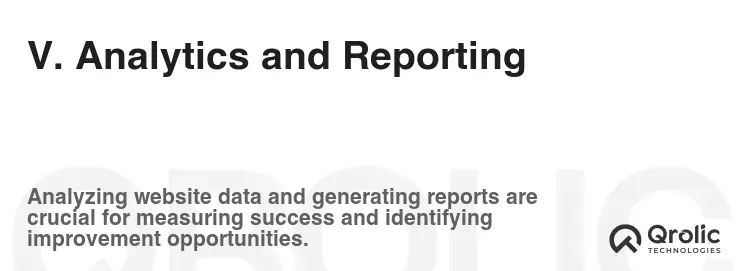
A. Setting Up Google Analytics and Google Search Console
1. Tracking Website Performance:
-
Google Analytics: Use Google Analytics to track website traffic, user behavior, and conversion rates.
-
Google Search Console: Use Google Search Console to monitor your website’s performance in search results, identify technical issues, and submit sitemaps.
2. Goal Tracking and Conversion Tracking:
-
Defining Goals: Define clear goals for your website, such as lead generation, form submissions, and sales.
-
Setting Up Goal Tracking: Set up goal tracking in Google Analytics to measure the success of your website in achieving its goals.
3. Regular Monitoring and Analysis:
-
Identifying Trends and Patterns: Regularly monitor and analyze your website’s analytics data to identify trends and patterns.
-
Making Data-Driven Decisions: Use your analytics data to make data-driven decisions about your website’s design, content, and marketing strategies.
B. SEO Reporting and Client Communication
1. Creating Comprehensive SEO Reports:
-
Key Metrics to Include: Include key metrics such as organic traffic, keyword rankings, backlinks, and conversions in your SEO reports.
-
Visualizing Data: Use charts and graphs to visually represent the data in your reports.
-
Providing Insights and Recommendations: Provide clear insights and recommendations based on the data in your reports.
2. Regular Communication with Clients:
-
Keeping Clients Informed: Keep clients informed about the progress of their SEO campaigns.
-
Providing Transparency: Provide transparency into your SEO strategies and tactics.
-
Building Strong Relationships: Build strong relationships with your clients by providing excellent service and communication.
VI. Qrolic Technologies: Your Partner in Digital Growth

Qrolic Technologies (https://qrolic.com/) is a leading provider of digital marketing solutions, including SEO, web development, and content marketing. We help businesses of all sizes achieve their online goals by leveraging cutting-edge technologies and data-driven strategies.
How Qrolic Technologies Can Help SEO Consultants:
-
Website Development and Design: We can help you create a high-performing website that is optimized for SEO and user experience.
-
Content Creation and Marketing: We can help you create high-quality content that attracts and engages your target audience.
-
SEO Consulting and Implementation: We can provide expert SEO consulting services to help you improve your website’s visibility in search results.
-
Technical SEO Audits: We can conduct comprehensive technical SEO audits to identify and address any issues that may be hindering your website’s performance.
Partner with Qrolic Technologies to unlock your full potential and achieve sustainable growth.
VII. Conclusion: Building a Winning Website for SEO Success
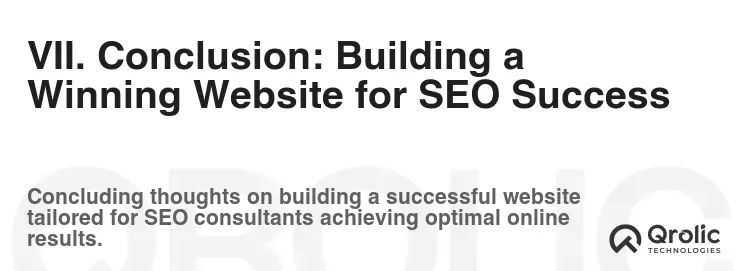
Creating a successful website for an SEO consultant requires a multifaceted approach that encompasses technical SEO, content strategy, lead generation, and analytics. By implementing the key features and strategies outlined in this article, you can build a website that not only attracts potential clients but also establishes you as a trusted authority in the SEO industry. Remember to continuously monitor your website’s performance, adapt to changes in the SEO landscape, and prioritize user experience to achieve long-term success.









